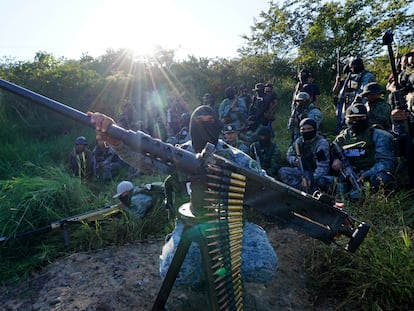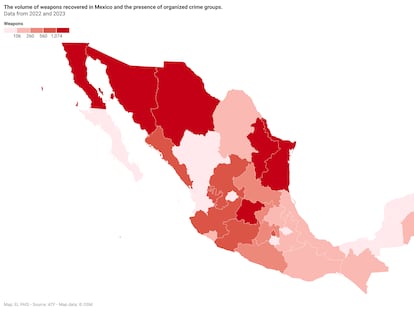From fentanyl to avocado: The many faces of the Mexican cartels targeted by Trump
The designation of six Mexican criminal groups as terrorist organizations, which takes effect on February 20, raises questions about their size, activities, and territorial reach
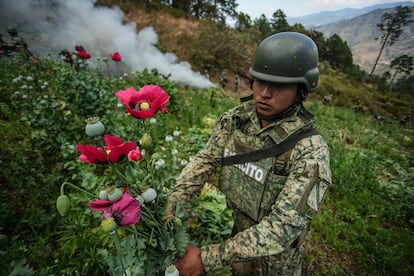
Threat fulfilled. The United States has designated six Mexican criminal groups, including the Sinaloa Cartel and the Jalisco New Generation Cartel (CJNG), as terrorist organizations, responding to the fears of the new administration: fentanyl, migration, and attacks on its citizens on Mexican soil. It is, apparently, a unilateral decision, taken in Washington without any negotiation with the government of Claudia Sheinbaum in terms of relevance or possible cooperation. The decision of the Trump administration comes into force on February 20. In addition to generating doubts about its implications, the measure questions the nature of these six groups, all of different sizes, capacities, and scopes.
Eduardo Guerrero, general director of Lantia Intelligence, makes a first comparison between the six. “The CJNG is everywhere, it is very aggressive and participates in the export of fentanyl to the U.S. and the trafficking of migrants. The Sinaloa Cartel ceased to exist as such, rather they will have to decide which families to target, which ones have the largest number of fentanyl laboratories. The Gulf Cartel does not exist as such either: there is a collection of cells that were once part of it, dedicated above all to human trafficking,” he says. “Then there is the Cárteles Unidos,” he adds, “which was an organization created by the Sinaloa Cartel to support them against the CJNG, and which must now be in decomposition. La Nueva Familia Michoacana, led by the Hurtado Olascoaga brothers, is one of those that has killed the most police officers in recent years, and the one that has grown the most. And the Cartel del Noreste is a mafia from Tamaulipas, a split from Los Zetas,” he concludes.
Here's a look at each one.
Sinaloa Cartel
Washington’s nemesis in terms of security. No other criminal organization has given the U.S. justice system more work than the Sinaloa Cartel. Its last great capo, Joaquín “El Chapo” Guzmán, will spend the rest of his life in prison in the U.S. after his conviction in 2019 for drug trafficking and other crimes. The great institutional facilitator of the Sinaloa Cartel in the 21st century, the security czar of the Felipe Calderón administration (2006-2012), Genaro García Luna, is also serving a sentence there.
In recent years, two of El Chapo’s sons and two old allies have fallen into Washington’s clutches, among other figures linked to the group. Among their priority targets are currently another of El Chapo’s sons, Iván Archivaldo Guzmán, leader of one of the cartel’s factions, Los Chapitos, and Isidro Meza Flores, “El Chapo Isidro,” accused of trafficking huge quantities of drugs north of the Rio Grande. For the former, the authorities are offering up to $10 million for information leading to his capture, for the latter, $5 million.
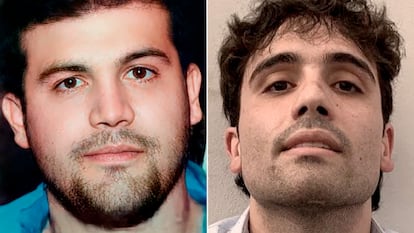
“The Sinaloa Cartel is largely responsible for the massive influx of fentanyl into the United States over the past eight years or so,” the Justice Department said in a press release it issued in 2024 regarding an indictment of several members of the group. “The cartel’s activities generate enormous sums of money in the United States that belong to the cartel in Mexico. Drug trafficking profits are repatriated to Mexico for use by the cartel,” it added.
Jalisco New Generation Cartel
The heir to Los Zetas in terms of communication and propaganda, the CJNG is the only criminal group with a presence throughout Mexico, along with what until a few months ago was the Sinaloa Cartel, according to Lantia. Born in the heat of methamphetamine production and trafficking from Michoacán to the U.S., the group has expanded relentlessly throughout Mexico, under the orders of its elusive leader, Nemesio Oseguera Cervantes, “El Mencho,” and his close entourage.
A logic of franchises prevails in the universe of the CJNG. Dozens of gangs across the country use its acronym. Although the relationship between franchise and franchisees has never been very clear, the ubiquity of the four letters feeds an impression of great power. Fights between groups allied with the Sinaloa Cartel in Chiapas, over migrant transit routes, occur at the same time as other battles between other allied groups with regional mafias in Guanajuato for control of the fuel theft points from Pemex pipelines.
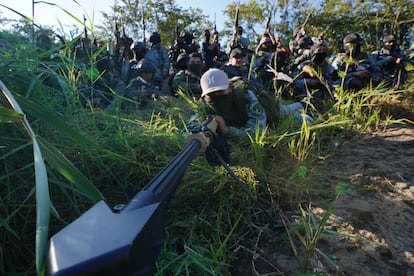
Washington has been keeping an eye on the CJNG for years. Last year, the U.S. courts convicted El Mencho’s son, Rubén Oseguera González, alias “El Menchito,” for cocaine and methamphetamine trafficking and firearms use. It is not yet known how many years he will spend in prison. In the statement released after the conviction, former Attorney General Merrick B. Garland said that “El Menchito led the Jalisco Cartel’s efforts to use murder, kidnapping, and torture to build the Cartel into a self-described ‘empire’ by manufacturing fentanyl and flooding the United States with massive quantities of lethal drugs.”
La Nueva Familia Michoacana
Led by the Hurtado Olascoaga brothers, particularly Johny Hurtado, alias “El Pez,” this criminal group operates mainly in Guerrero and the State of Mexico. David Saucedo, an expert on the criminal dynamics in the center of the country, says that “La Nueva Familia Michoacana is the third most important macrocriminal group in the country.” Saucedo believes that their inclusion on the list of terrorist organizations is preventive. “I suppose that the Americans want to prevent the Hurtado brothers from benefiting from a possible erosion of the Sinaloa and Jalisco Cartels. It is like trying to give them a preemptive strike,” he argues.
Eduardo Guerrero is of the same opinion. “It is the group that has grown the most and Lantia already considers it a cartel,” he explains. The analysis center understands a cartel as a “confederation of mafias and gangs with a regional or national presence, that operate independently, but in a coordinated manner — and subject to the strategic decisions of a limited number of individuals or leaders — with the objective of generating economies of scale and successfully confronting external rivals.” Guerrero points out that the group has a presence in more than a third of the country’s 32 states and that its “financial prosperity” reveals its “rapid growth.” Saucedo points to the group’s extortion methods, even with multinationals like Coca-Cola, as an example of its aggressiveness.
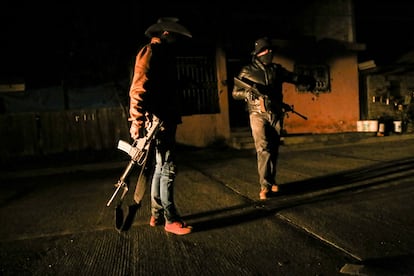
The Hurtado brothers stand out for the aggressiveness of their tactics. In the last five years, alleged members of their group have carried out massacres in Guerrero and the State of Mexico, of civilians and authorities, such as the murder of 13 state agents in Texcaltitlán in 2021, or the massacre of 20 people in October 2022 in San Miguel Totolapan, among them the mayor and his father.
Gulf Cartel
Fragmented to the bone, the old Gulf Cartel is today an amalgam of criminal gangs that commit crimes on the border between Tamaulipas and Texas and that, according to Lantia Intelligence, are mainly dedicated to migrant trafficking. It has not been ruled out that some of the gangs are engaged in drug trafficking. Not in vain, its last two great leaders, Osiel Cardenas, “El Mata Amigos,” and Jorge Costilla-Sánchez, “El Coss,” served or are serving sentences in the U.S. for trafficking cocaine and marijuana.
At the head of the Gulf Cartel, Cárdenas created Los Zetas at the beginning of the century, an armed wing of the criminal organization initially made up of deserting soldiers. The story is well-known. Cárdenas was arrested and Los Zetas became independent, turning extortion into their business model, using terror to impose their rule. The independence of Los Zetas triggered a war with their old allies that ultimately ended with the dissolution of both groups.
Tamaulipas is now home to at least 15 criminal groups of different sizes and scopes, including Los Ciclones, Los Escorpiones, Los Pelones, Los Metros, and Los Rojos. The kidnapping of four U.S. citizens in March 2023 in Matamoros, allegedly at the hands of a Los Escorpiones unit, and the death of two of the four, could support the inclusion of the Gulf Cartel on the list.
For U.S. agencies, the Gulf Cartel is an organization dedicated to drug trafficking, among other areas, such as illegal fishing and trafficking of marine species. In addition to the arrests and convictions of Osiel Cárdenas and Jorge Costilla, U.S. authorities have in recent years had the alleged successor to both, José Alfredo Cárdenas, alias “El Contador,” in their sights for drug trafficking. Cárdenas was arrested in 2022, but a judge released him at the end of last year.
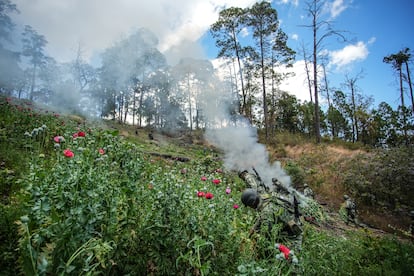
Cárteles Unidos
Born as an alliance of mafias and regional gangs in Michoacán, Cárteles Unidos integrated the remains of the Los Caballeros Templarios or Los Viagras, among others. Its reason for being was to fight the CJNG for spaces of power in the Tierra Caliente region of Michoacán, from Tepalcatepec to Nueva Italia, passing through Apatzingán. During 2021, the battle between both groups was bloody. The CJNG pushed from the Sierra Costa region towards Tierra Caliente, turning the route between Aguililla and Apatzingán into a literal battlefield, with (homemade) tanks and trenches on the road.
Over the years, this strange alliance seemed to decline, a situation that Guerrero confirms. Despite this, their criminal activities have been well documented in recent years. Saucedo points out that the group “was behind the kidnapping of two American phytosanitary inspectors not long ago” in reference to the case of two workers from the Animal and Plant Health Inspection Service, who were assaulted and detained in Michoacán, where they were inspecting avocado orchards and packing plants. Because of this issue, Joe Biden’s administration stopped the inspections, which generated concern in the sector.
“Due to the tax on exported goods, lemons and avocados have become more expensive in supermarkets in the United States,” Saucedo continued. “American citizens have been murdered in Michoacán in an atrocious manner,” he added. The most recent case was that of two American students, killed in December when they arrived in the state to spend the Christmas vacation.
Cartel del Noreste
The Cartel del Noreste (CDN) is the brand name of the main Los Zetas splinter group in western Tamaulipas, mainly in Nuevo Laredo. Lantia does not classify it as a cartel, as it does with the CJNG, the Sinaloa Cartel, or La Nueva Familia Michoacana. For Lantia, it is a mafia, that is, a “regional organization with family or friendship ties, made up of armed branches or gangs. They form part of cartels, they are subcontracted to them, or they work independently.”
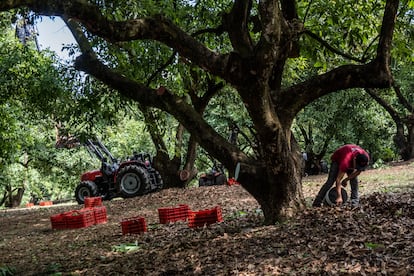
As part of agreements between the Mexican and U.S. governments to avoid the imposition of tariffs on Mexican export products, the Sheinbaum administration has targeted this criminal group. At the beginning of the month, the Secretariat of Security and Citizen Protection announced the arrest of “Ricardo González Sauceda, alias ‘El Ricky,’ regional leader in Nuevo León, Tamaulipas, and Coahuila of the Cartel del Noreste.” According to the agency, El Ricky was “the second most important man within the criminal organization, below Juan Cisneros Treviño, alias “Juanito Treviño.”
Like Los Zetas before them, the CDN has been the protagonist of violent attacks against security forces in Tamaulipas and Nuevo León. Nowhere else in Mexico has the army participated in more confrontations with suspected criminals than in Nuevo Laredo, a CDN stronghold. In many cases, civil society organizations have denounced abuses by soldiers. Although there are more far-reaching Zetas splinter groups, such as Los Zetas Vieja Escuela, the Justice Department considers the CDN to be the successor organization.
Sign up for our weekly newsletter to get more English-language news coverage from EL PAÍS USA Edition
Tu suscripción se está usando en otro dispositivo
¿Quieres añadir otro usuario a tu suscripción?
Si continúas leyendo en este dispositivo, no se podrá leer en el otro.
FlechaTu suscripción se está usando en otro dispositivo y solo puedes acceder a EL PAÍS desde un dispositivo a la vez.
Si quieres compartir tu cuenta, cambia tu suscripción a la modalidad Premium, así podrás añadir otro usuario. Cada uno accederá con su propia cuenta de email, lo que os permitirá personalizar vuestra experiencia en EL PAÍS.
¿Tienes una suscripción de empresa? Accede aquí para contratar más cuentas.
En el caso de no saber quién está usando tu cuenta, te recomendamos cambiar tu contraseña aquí.
Si decides continuar compartiendo tu cuenta, este mensaje se mostrará en tu dispositivo y en el de la otra persona que está usando tu cuenta de forma indefinida, afectando a tu experiencia de lectura. Puedes consultar aquí los términos y condiciones de la suscripción digital.
More information
Archived In
Últimas noticias
Chris Martin, Taylor Swift, Elijah Wood and other famous wedding ‘crashers’
‘How does it feel to be a failure?’: Elizabeth Berkley’s journey from ‘Showgirls’ ridicule to vindication
The story of the Málaga virus: The code that haunted Google’s cybersecurity center director for 30 years
The impact of Ecuador’s mega-prison: A polluted river, cleared forests and military checkpoints
Most viewed
- Christian Louboutin: ‘Young people don’t want to be like their parents. And if their parents wear sneakers, they’re going to look for something else’
- The low-cost creative revolution: How technology is making art accessible to everyone
- Liset Menéndez de la Prida, neuroscientist: ‘It’s not normal to constantly seek pleasure; it’s important to be bored, to be calm’
- All the effects of gentrification in one corner of Mexico’s Colonia Roma
- December Social Security and SSI payments: Dates, double checks and the 2026 COLA increase

